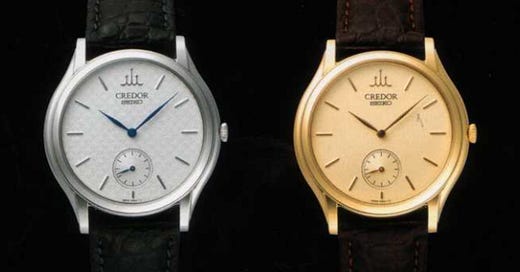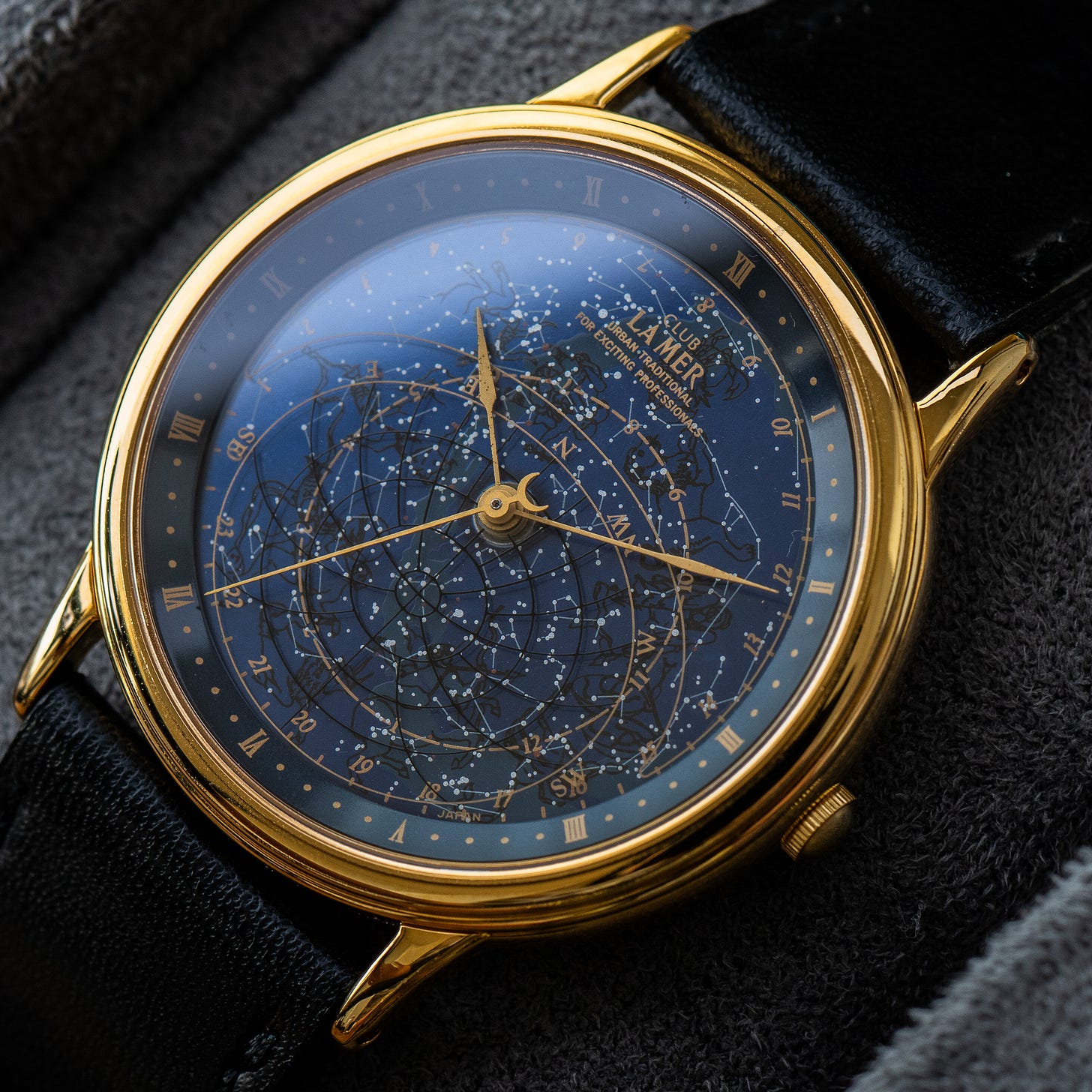The Precursor
Today I’m excited to be able to write about the brand that made my first ever watch, and believe it or not, it isn’t Japanese! I won’t spoil the surprise, but it’s a really neat vintage reference - and it has a 39mm case width, which is oddly large for a 75 year old watch.
But first, a lesson in noticing the finer details.
Credor “Flowing Water” GBBE990 (LE 50)
It would be all too easy to overlook this watch. I often picture myself flipping through neo-vintage Credor catalogues. Which models would’ve caught my eye back then? Which have stood the test of time? One thing’s certain - the gold GBBE990 pictured above wouldn’t have got a second glance. An 18K gold case, housing a 68 calibre with small seconds. Pretty? Sure. But not remarkable enough to stop me from turning the page.
What a fool that imaginary, early-2000s version of myself was. Or perhaps print technology is to blame for not representing what was truly on offer?
Please forgive me GBBE990 - I wasn’t familiar with your game.
As many of you will know, neo-vintage Credors often highlight the 2, 4, and 7-hour markers. These are designed to serve as a quiet reminder - the importance of making every second count in your own 24/7. And the 2002-produced watch on offer today bears the same message, but in a far subtler form.
The dial, representing the ceaseless flow of time, is a unique design element I haven’t seen Credor use before or since. And while I love the dial, I know there’s a razor-thin 68 calibre lurking inside the 18k gold case - so I can’t help but wonder what delights Seiko’s master engraver, Kiyoshi Terui, has got in store for us this time? Let’s flip this thing over and gaze through the exhibition caseba-
Oh.
I’m a rational human being. I shouldn’t demand unique engravings every time I see a 68 calibre. At the time, Terui dutifully worked as Seiko’s only master engraver - he was a busy man, so I can’t reasonably expect every piece to be a showstopper. And yet, I still feel a pang of disappointment. Maybe that hypothetical, catalogue-flipping version of me was right to swipe left.
Hang on, are those hinges?
Terui-san, you son of gun. You’ve done it again. Masterful.
The “river of time” motif extends to the movement, and in a more direct manner. Tilt the watch in your hands and light darts across the sharp edges of Terui’s river, rippling like a gentle current, bringing the scene to life.
Perlage always entrances, but it typically comes in one of two flavours:
Sparingly applied as finishing to specific parts of the movement, visible through an exhibition caseback
Liberally applied to the caseback’s underside, visible only when you remove the caseback
This hinged caseback allows for the best of both worlds - perlage that stays hidden until summoned, delivering its hypnotic beauty at a moment’s notice.
By virtue of it appearing in this newsletter, it’s obvious I was wise enough not to overlook the GBBE990 - and nor should you. Limited to just 50 pieces, it’s a rare dress watch with a unique identity. If you're after something quietly distinctive, you know where to click.
By the time you read this, I will have posted the video on my Instagram. Definitely worth seeing in action. Be a good sport and give it a like while you’re there!
The Credor GBBE990 is now available to buy on our website
In great condition. Hairlines visible on the gold case, with some aging and patination around the edges of the case. All very removable if that’s your preference. Credor leather strap and buckle. With box, no papers.
Citizen “Cosmosign” 4390-432100
An obvious precursor for a popular Citizen line. The Citizen La Mer - French for “The Sea” - was one of the founding models in the brand’s Club La Mer line: an elegant sub-brand created exclusively for the Japanese domestic market.
You’ll no doubt recognise the dial as an early prototype of the Campanola Cosmosign, and you’d be right. La Mer Cosmosign watches were among the early inspirations behind the modern Campanola collection.
Released in 1986, this was the world’s first scientifically accurate star chart wristwatch. Citizen was so proud of its precision that it originally included a loupe to help owners examine every celestial detail. But why is a cosmic watch called The Sea? To pay tribute to ancient Japanese sailors that were guided by the stars, of course!
The planisphere chart rotates in real time, displaying the current position of the stars above. It also shows daily sunrise and sunset times - a charmingly analogue way to stay connected to the sky.
In line with the dial text, I’m legally obliged to only sell this watch to “exciting professionals”, so don’t waste my time and yours if that doesn’t apply to you. And if you have to ask what an “exciting professional” is, you already don’t qualify.
The Citizen 4390-432100 is available to buy on our website
In very good condition overall. Some minor hairlines and marks on the gold plating, and the hands show signs of aging, but nothing you’d notice on the wrist.
It’s not Japanese, but it’s very pretty…
Breitling Chronograph Ref. 1188
The origin of an icon. Breitling has always had a special place in my heart. My father would occasionally let me wear his when I was younger, so I’ve always thought of the brand as my “first watch”.
To pre-emptively satisfy any naysayers that claim borrowing a watch “doesn’t count”, the first watch I bought for myself was a Breitling Montbrilliant Datora A21330. I still have it, and presumably always will, despite my interests definitively shifting towards Japanese watchmaking.
When I came across this 1950 Breitling chronograph, I was instantly drawn to its rich patina - but it was the hour markers that really hooked me. Nothing says vintage quite like Art Deco numerals. I’d never seen Breitling use these before, and after a bit of digging, I found that they only appeared briefly in the late 1940s and early ’50s on a handful of models.
Inside beats the Vénus 188 - a cam-actuated chronograph calibre that may not be familiar by name, but whose legacy certainly is. Praised for its robustness and ease of servicing, it became the movement of choice as sportier watches gained popularity in the 1950s. Eventually, it caught the attention of Valjoux, who acquired Vénus and reworked the movement into the Valjoux 7750 - and later still, it became known as the ETA 7750, after ETA acquired Valjoux.
There’s always a bigger fish.
If you’ve worn a neo-vintage or modern chronograph, chances are you’ve encountered this family of movements. The 7750 powers models found in collections like:
Breitling Navitimers
Omega Speedmasters
IWC Pilots
Tag Heuer Carreras
And various Sinn, Tissot, Oris, Longines, and Hamilton Chronographs
Ubiquitous is almost an understatement.
The Vénus 188 appears in many vintage Breitlings (and other brands) from the era - including the Sprint, Cadette, and Premier. But none have charmed me quite like the Antimagnetic variant featured here. The combination of patina and Deco elegance gives it a maturity that’s hard to beat.
The Breitling Chronograph Ref. 1188 is available to buy on our website
In a delightfully aged condition. Just serviced. Marks everywhere, but all original. The original chrome plating has worn away at the edges, so the nickel is visible throughout.
Watches you’ve seen before…
Two modern favourites. A SCVE and SARY. Both watches had tiny JDM-only production runs, making them feel like rare limited editions.
Seiko “Black Guilloche” SARY007
And both are available to buy on our website:
Please click on the link above to read each condition report and see additional photos.
Don’t forget to follow my Instagram to see all of the watches above in full cinematic glory next week.


















The perlage on the inside of that hinged caseback is very cool